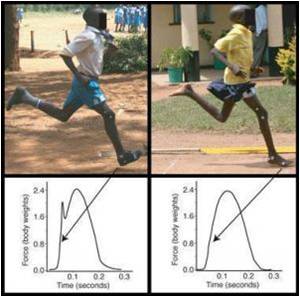 Last fall, I posted on the benefits of barefoot running. Since that time, I have attended meetings and new research has been published to support, if not true barefoot running, some of the changes that seem to accompany it.
Last fall, I posted on the benefits of barefoot running. Since that time, I have attended meetings and new research has been published to support, if not true barefoot running, some of the changes that seem to accompany it.
As a quick review,
- As the cadence increased, the stride length decreased.
- As stride length decreased, the runners bounced less and produced lower braking forces against the ground.
- A shorter stride allowed the knee (and hip) to do less work absorbing energy.
- A shorter stride allowed the knee to bend less during stance, and decreased many hip motions.
Well, a recent article published in Medicine and Science in Sports & Exercise (MSSE) by Harvard researchers reached an interesting conclusion. Collegiate cross country runners that consistently land on their heels first become injured about twice as often as those that forefoot strike.
Think about how you run . . . do you land with your heel first? Most runners do. Interesting is why landing on the heel seems to cause more injuries. Enter impulse . . .
What the heck is impulse?
Biomechanically, impulse is force multiplied by the time of force application. The way most runners run (by hitting with their heels first) actually causes their bodies to experience two separate forces. When experiencing two separate forces, the runners that run this way have two separate times when injury might occur.
Take a look at the picture to the right.
The picture on the left shows the two force peaks of a runner striking the ground with his heel first.
In the picture on the right, the runner basically strikes the ground with the ball of his foot. Look at the resulting forces. The first peak has been nearly eliminated.
So how to run?
Does this mean you should change how you run? Interesting question without an easy answer. One of the authors (Daniel Lieberman) of the study cited above states, “If you’re not getting hurt, then absolutely not. If it’s not broke, don’t fix it.”
However, if your goal is to both reduce your risk of injury AND improve running performance, a switch to more forefoot (ball of the foot) initial impact is something to strongly considered. Not only does this landing pattern reduce the risk of injury, it also makes runners more efficient.
If you do you consider changing from a heel strike to a mid-foot/forefoot strike, DO SO GRADUALLY! I have worked with a great number of runners with increased calf pain/soreness and foot injuries. (Another co-author of the MSSE article as said that he “broke a metatarsal while running (his) first marathon after transitioning a bit too quickly and expecting a bit too much from my body too soon”
So go slow, I think you’ll like the change!
